Adventure on the Ice
Everest it is not, but New Zealand’s Westland National Park offers up some very chilly and formidable reminders of inhospitable terrain and inhuman climate.  Both confront a weekend warrior who ventures into the ice flows that descend from the giant white shoulders of Mount Cook on the south island. A walk into the alien world of the Fox Glacier or the nearby Franz Joseph Glacier is more than sufficient to determine if your soul connects to the brittle world of freezing thin air, sculpted blue ice and gaunt rock escarpments.
Both confront a weekend warrior who ventures into the ice flows that descend from the giant white shoulders of Mount Cook on the south island. A walk into the alien world of the Fox Glacier or the nearby Franz Joseph Glacier is more than sufficient to determine if your soul connects to the brittle world of freezing thin air, sculpted blue ice and gaunt rock escarpments.
Our turn to find out came early in the fall (April) when we signed up for a guided hike up and onto the Fox Glacier, a great tongue of ice that crawls down the west slope of the 12,000 foot Mount Cook, New Zealand’s 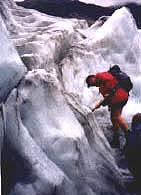 highest summit. It was no simple task, beginning with strapping fifteen pounds of cleated ice boots to our feet, and donning heavy parkas over our heads–weighty signs indeed about the unsteady course ahead into an unsteady climate. Although weather predictions for the day were moderate, at any time a freezing front could blow in bringing rain, snow, blinding clouds or wind.
highest summit. It was no simple task, beginning with strapping fifteen pounds of cleated ice boots to our feet, and donning heavy parkas over our heads–weighty signs indeed about the unsteady course ahead into an unsteady climate. Although weather predictions for the day were moderate, at any time a freezing front could blow in bringing rain, snow, blinding clouds or wind.
Duly warned and clothed, our intrepid little group followed our seasoned glacier guide with the thick thighs up a very narrow path. Half an hour later we passed through a rainforest.
Rainforest? This is only one of two glaciers in the world (the other, Franz Joseph Glacier a few miles north) whose melting point extends so far down a valley as to reach below the dense rainforest tree line. A steep rock face mountain valley forces the frozen glacier mass far down before it reaches sufficient temperate air to melt into frigid and often-raging rivers. On the way down, the ice cuts through the tropical botanical layer of the South Island. It is strange sight: jungle vegetation on one side and frigid glacial ice on the other.
Alien World of Blue and White
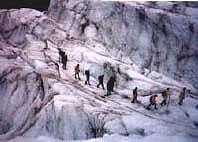 The most unsettling part of walking a glacier is the ferocious inhospitality of the place. It groans, cracks, breaks up into freight car-sized chunks, scoops up great black boulders and yawns crevices that could swallow a house. Standing in the middle of this giant frozen tongue, there are no comforting signs of life; no footprints, leaves, trees, birds–just the white striped frozen muscle of a thousand year old inland ice flow that moves up or down the valley a yard a day depending how cold the present conditions are.
The most unsettling part of walking a glacier is the ferocious inhospitality of the place. It groans, cracks, breaks up into freight car-sized chunks, scoops up great black boulders and yawns crevices that could swallow a house. Standing in the middle of this giant frozen tongue, there are no comforting signs of life; no footprints, leaves, trees, birds–just the white striped frozen muscle of a thousand year old inland ice flow that moves up or down the valley a yard a day depending how cold the present conditions are.
These two glaciers are certainly New Zealand’s most bizarre natural idiosyncrasies as they creep down from the white heights of the Southern Alps toward the dark Tasman Sea. The ever-changing trail is more like an obstacle course with no level surfaces between the rocks, crags, cliffs and crevices. After two hours climbing upward we finally reached a safe walkable area on the ice and our little group stood, mouths agape, looking at the vast alien and spectacular scene that engulfed us.
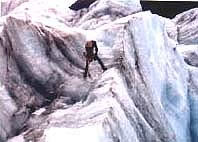 Far below was the harrowing portal cave at the front toe of the glacier gushing with frigid dirty water into the stony river bed underneath. It’s a gaping mouth like a giant albino alligator and no less friendly. In a heartbeat, a foolish trespasser could be crushed beneath a collapsing ancient wall of melting ice or washed away with no warning and no second chance.
Far below was the harrowing portal cave at the front toe of the glacier gushing with frigid dirty water into the stony river bed underneath. It’s a gaping mouth like a giant albino alligator and no less friendly. In a heartbeat, a foolish trespasser could be crushed beneath a collapsing ancient wall of melting ice or washed away with no warning and no second chance.
Delicate Trail
Surrounded by great chunks and cones of blue ice, it is a harrowing and daunting place for a traveler on foot. For a moment it reminded me of ‘The Last Place on Earth’, the Antarctic story of the Amundsen-Scott race to the South Pole–only the Norwegians came out alive. Scott and the British team froze to death.
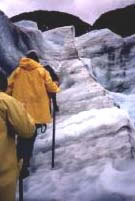 Fortunately we were reassured by the lead and experience of our guide who took us along a daily-tested path with chiseled steps. Yet his assurance was also full of warning and constant reminding: do not go off the path, do not attempt to lean over and look down a crevice, stay away from overhanging ice–and hold on to your walking stick.
Fortunately we were reassured by the lead and experience of our guide who took us along a daily-tested path with chiseled steps. Yet his assurance was also full of warning and constant reminding: do not go off the path, do not attempt to lean over and look down a crevice, stay away from overhanging ice–and hold on to your walking stick.
Of course, ten minutes later I dropped my stick down a small crevice as I tried to focus my camera. My heart skipped a beat as I thought of the whole group being put at risk for the sake of a single photo. However, almost as quickly as I dropped it, a young woman with a bit more pluck than I stepped down and retrieved it. (Funny how reactions can be exaggerated in such inhospitable places.) This was a no-man’s land and we had no business out here. It was freezing, windy, unstable–and thoroughly exhilarating.
Westlands National Park is an enormous expanse (200 square kms) of mountainous terrain on the west coast of the south island. There are 140 glaciers here among the enormous valleys of New Zealand’s highest peaks, including the tallest Mt Cook at 12,349 feet. Nearly 50 feet of precipitation a year falls on the upper frozen slopes of these mountains and glaciers collect as the accumulation exceeds the melt-off below. The Fox and Franz Joseph glaciers are the largest glaciers in the country.
Living Ice
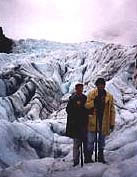 One of the eeriest aspects of these great white wedges is their movement. Given the incredible weight of the packed ice and the forceful pull of gravity the glaciers have been clocked at speeds up to 15 feet per day, very rapid by geologic measures. Our guide explained that in 1943 an aircraft crashed on the Franz Joseph Glacier about 4 km (2 1/2 miles) uphill. Six years later parts of the wreckage appeared at the glacier front–about six feet a day of unstoppable motion. Standing still at different places on the ice, we occasionally heard the unsettling grunts, pops and snaps as it scraped, crushed and gouged the rocky terrain underneath, pushing aside or engulfing elephantine boulders.
One of the eeriest aspects of these great white wedges is their movement. Given the incredible weight of the packed ice and the forceful pull of gravity the glaciers have been clocked at speeds up to 15 feet per day, very rapid by geologic measures. Our guide explained that in 1943 an aircraft crashed on the Franz Joseph Glacier about 4 km (2 1/2 miles) uphill. Six years later parts of the wreckage appeared at the glacier front–about six feet a day of unstoppable motion. Standing still at different places on the ice, we occasionally heard the unsettling grunts, pops and snaps as it scraped, crushed and gouged the rocky terrain underneath, pushing aside or engulfing elephantine boulders.
Once upon a glacier is a daunting, exhilarating, frightening and awe-inspiring place; it’s a reminder of the infinite and impersonal forces among which we frail humans live.

Also See:
Gay New Zealand Stories
Gay New Zealand News & Reports 2001 to present
Gay New Zealand Photo Galleries
















